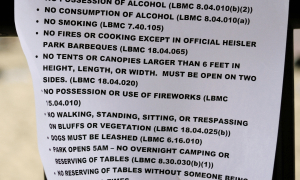 Californian legislators will soon consider another proposal to bring e-cigarettes into the ambit of tobacco legislation, with effects including a widespread ban on vaping in public places.
Californian legislators will soon consider another proposal to bring e-cigarettes into the ambit of tobacco legislation, with effects including a widespread ban on vaping in public places.
State senator Mark Leno, a San Francisco Democrat, and four co-authors have introduced senate bill 140 and expect it to be heard by senate policy committees in the spring.
Amending a raft of existing California legislation, it most notably would prohibit the use of e-cigarettes in nearly all enclosed workplaces.
The few exceptions would include very small businesses, certain areas of hotels and motels, and designated smoking rooms within workplaces (or “breakrooms”).
It would also impose more stringent penalties than currently exist for selling e-cigarettes to under-18s, with fines up to $6000 and suspension or revocation of a retailer’s licence (“seller’s permit” in Californian argot).
Defining tobacco products to include any “electronic device that delivers nicotine or other substances to the person inhaling from the device, including, but not limited to, an electronic cigarette, cigar, pipe, or hookah”, it would seem to also cover zero-nicotine e-cigs.
Deadly nicotine
“Whether you get people hooked on e-cigarettes or regular cigarettes, it’s nicotine addiction and it kills,” Leno was quoted as saying by the Reuters news agency. “We’re going to see hundreds of thousands of family members and friends die from e-cigarette use just like we did from traditional tobacco use.”
“No tobacco product should be exempt from California’s smoke-free laws simply because it’s sold in a modern or trendy disguise,” he also said in a separate statement. “Addiction is what’s really being sold.”
But his position – also apparently that of the bill’s sponsors, the American Cancer Society, American Heart Association and American Lung Association – was fiercely repudiated by Gregory Conley, president of the American Vaping Association, who said: “California’s so-called ‘anti-smoking’ groups seem to be spending more time fighting smoke-free vapor products than they are cigarettes.
“This bill represents just one of many actions taken as a part of a concerned misinformation campaign by activist groups that seek to frighten California smokers away from using low-risk vapor products, with the end result being that many will simply continue to smoke.”
Trying again
This is not the first attempt to define e-cigs as tobacco products in California. A bill nearly became law in 2009 but was vetoed by then-governor Arnold Schwarzenegger.
However, Leno has some track record with innovative legislation. When a city supervisor in San Francisco, he oversaw the passage of the country’s first ban on mercury thermometers.
Later, at state level, he authored a bill that was the first to be passed legalising same-sex marriages, although again it was struck down by the governor’s veto.
His public-health-related legislative work has covered issues ranging from HIV to the use of potentially toxic flame retardants in furniture.
What This Means: Previous attempts to regulate e-cigs at the state level in California have foundered at one point or another, as our recent special report on e-cigarette regulation in the state describes, and there is no guarantee that this will fare any better. Still, if it does pass the legislature, governor Jerry Brown would seem less likely to veto it than his predecessor Schwarzenegger. Brown approved a dozen Leno bills last year, and occupies broadly similar political territory.
Its passage would be a check on the e-cig market in America’s most populous state but not a terminal one. More significant might be its effect elsewhere: just as California was an oft-imitated pioneer of anti-smoking regulation – not least thanks to Stanton Glantz, now seen by some as the arch-foe of e-cigarettes – it could become a model for relatively restrictive vaping legislation.
Whichever way it goes in the end, we can expect plenty of very vocal criticism from the vaping community over the coming months, given Leno’s unambiguous opposition to e-cigs and his apparent misunderstanding of where smoking’s danger lies.
– Barnaby Page ECigIntelligence staff
Photo: Teakwood






